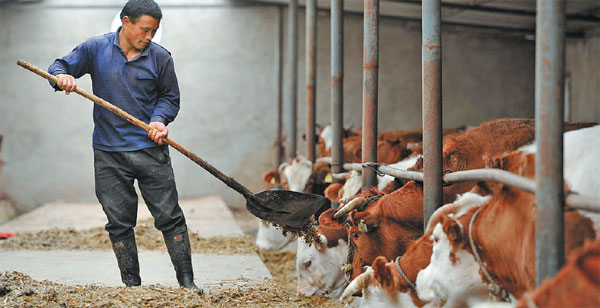Beef imports forecast to double by 2018
Updated: 2014-07-24 07:16
By Lyu Chang (China Daily)
|
||||||||
Beef imports to China are likely to double by 2018, Rabobank Group said in a report on Wednesday.
Pan Chenjun, a senior analyst at the bank, said domestic beef output is declining at the same time as there's a growing demand for high-protein food in China.
"The domestic beef industry is lagging behind all major beef-producing countries in terms of breeding, productivity, farm management, grassland and feed resources and other key aspects," said Pan. "In other words, China will still need to rely on beef imports."
|
A worker feeds cattle at a farm in Jingyuan county in the Ningxia Hui autonomous region. China's beef production is expected to reach 7.86 million metric tons by 2020. Peng Zhaozhi / Xinhua |
China, the world's biggest meat consumer, became a huge beef importer in 2013 as inward shipments almost quadrupled year-on-year to about 300,000 metric tons, according to the bank.
The bank has forecast annual import growth of 15 to 20 percent in the next five years, although the actual volume of imports may actually be double the official figures because of widespread smuggling.
"Cattle farmers are shifting to other agribusinesses due to a lack of government support and the large amounts of time and money required to raise cattle," Pan said. "Major players are facing the dilemma of where to source beef supplies."
To boost domestic output, China has increased support to the beef industry, but not enough to fill the gap between demand and supply.
The country aims to increase production from 6.3 million tons in 2013 to 7.17 million tons in 2015 and 7.86 million tons in 2020, according to the report.
There are also signs that China is changing its stance on beef imports. Pan said China is likely to lift the mad cow-related ban on Brazilian beef within the year and allow US beef imports in the next two years.
Australia, which is China's top supplier with about 52 percent of total imports during the first five months of the year, faces declining output because of a serious drought.
lvchang@chinadaily.com.cn
(China Daily USA 07/24/2014 page13)

 Chinese business leader feels at home in Cuba
Chinese business leader feels at home in Cuba
 China, Cuba ink cooperation pacts
China, Cuba ink cooperation pacts
 Rebels hand over black boxes
Rebels hand over black boxes
 Cuban artist seeks threads of humanity
Cuban artist seeks threads of humanity
 Jasmine Ballet Group shows talent
Jasmine Ballet Group shows talent
 President Xi honored in Venezuela
President Xi honored in Venezuela
 A bike ride helps Cuban editor fit into Chinese society
A bike ride helps Cuban editor fit into Chinese society
 Chinese students fall for Cuba
Chinese students fall for Cuba
Most Viewed
Editor's Picks

|

|

|

|

|

|
Today's Top News
36 bodies found from Taiwan plane crash
Xi visits old friend Fidel Castro
Li: The US should adopt 'open stance'
Food scandal pulls in Starbucks, Burger King
Symposium looks at China's healthcare sector
New scare hits fast food chains
Investigators examining MH17 victims
Beijing, Caracas sign multiple agreements
US Weekly

|

|







